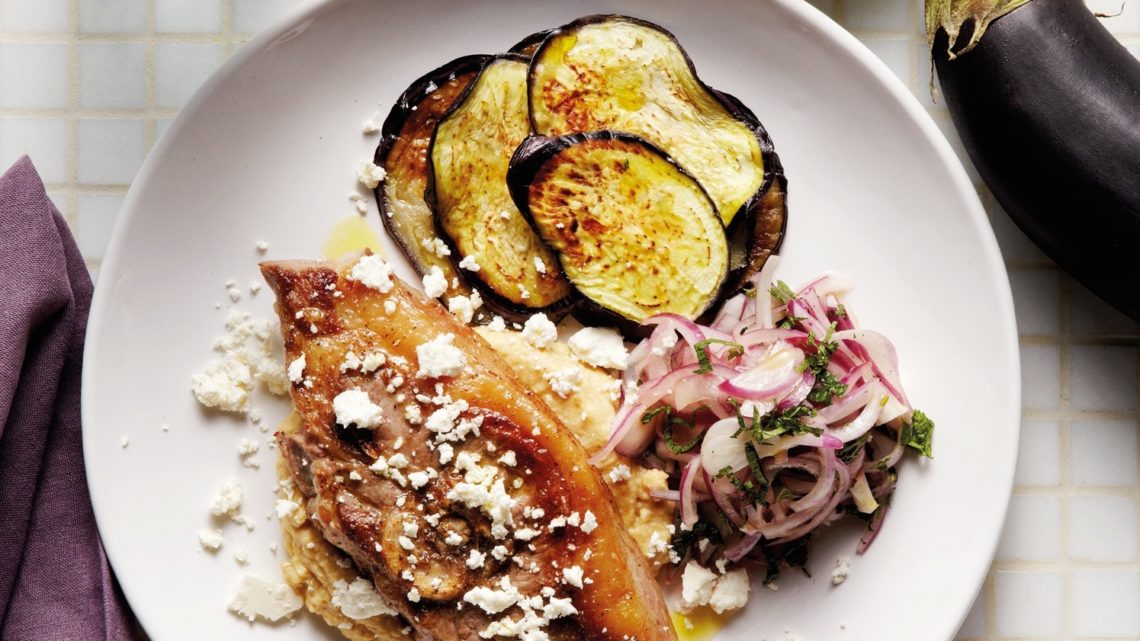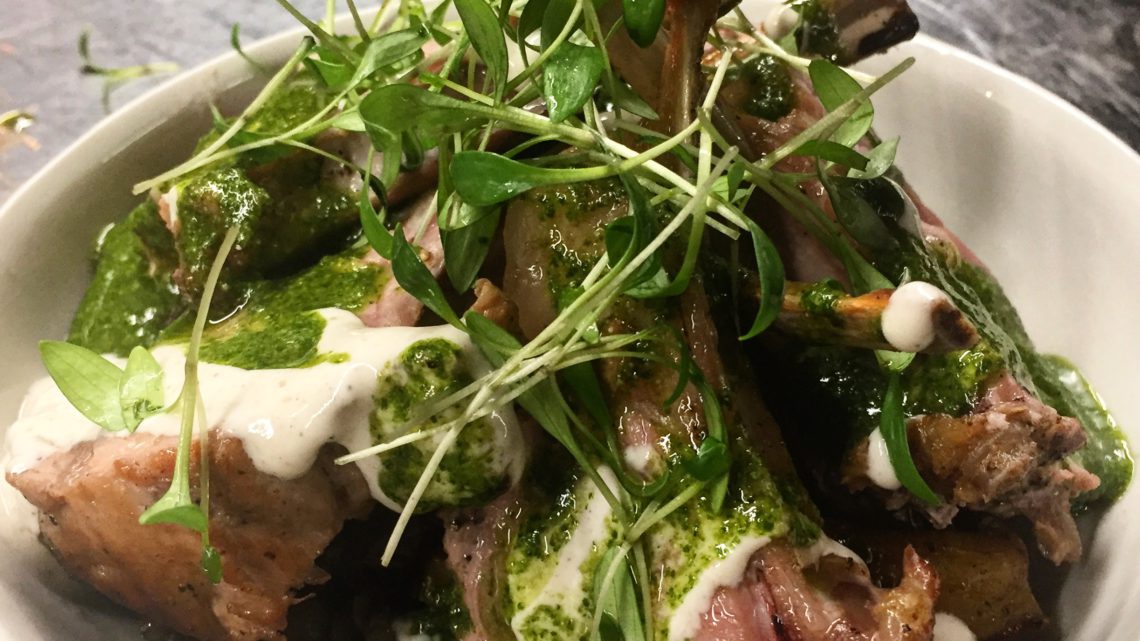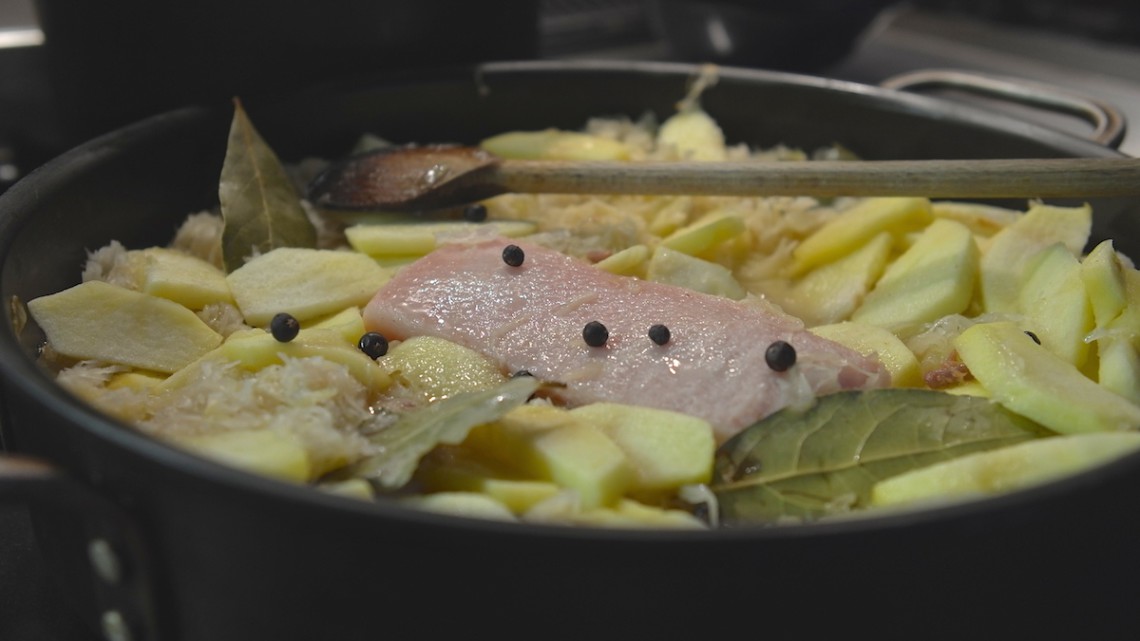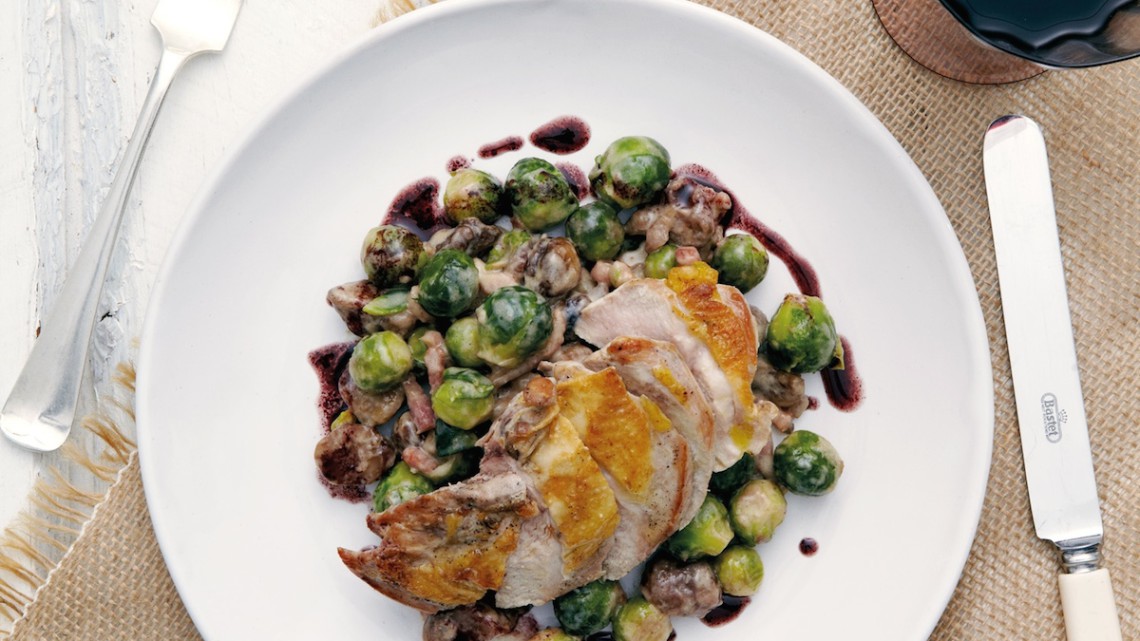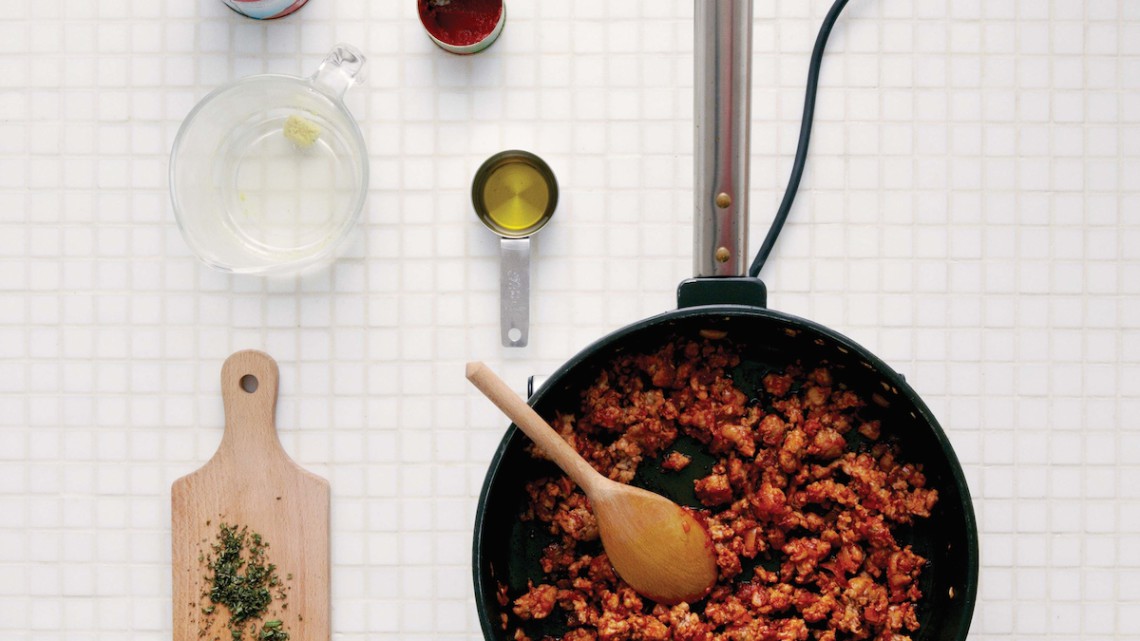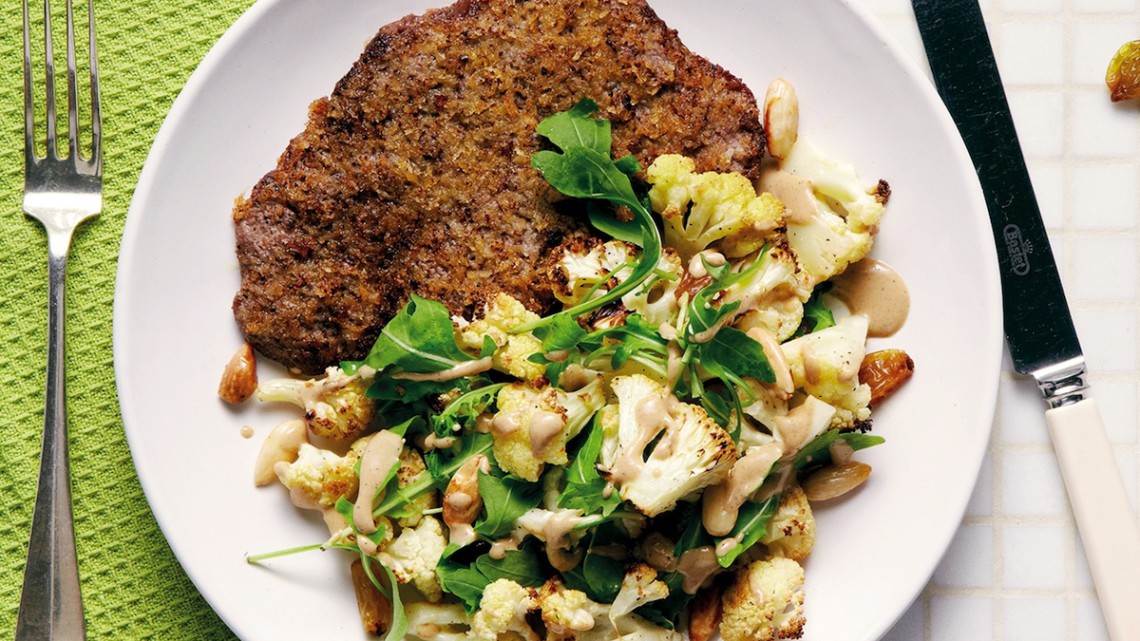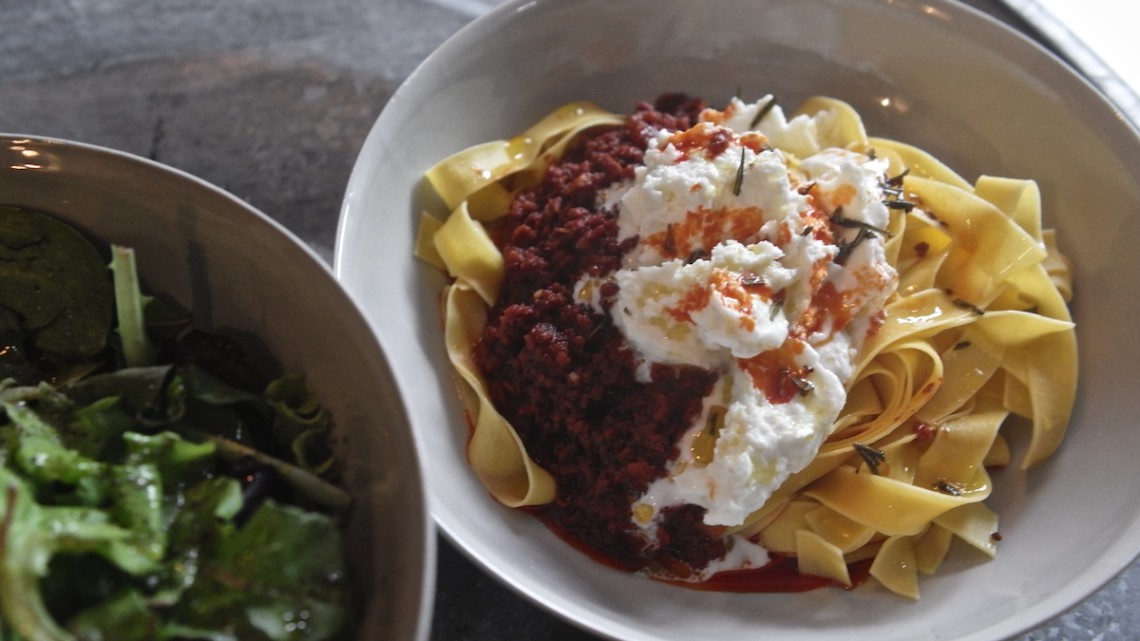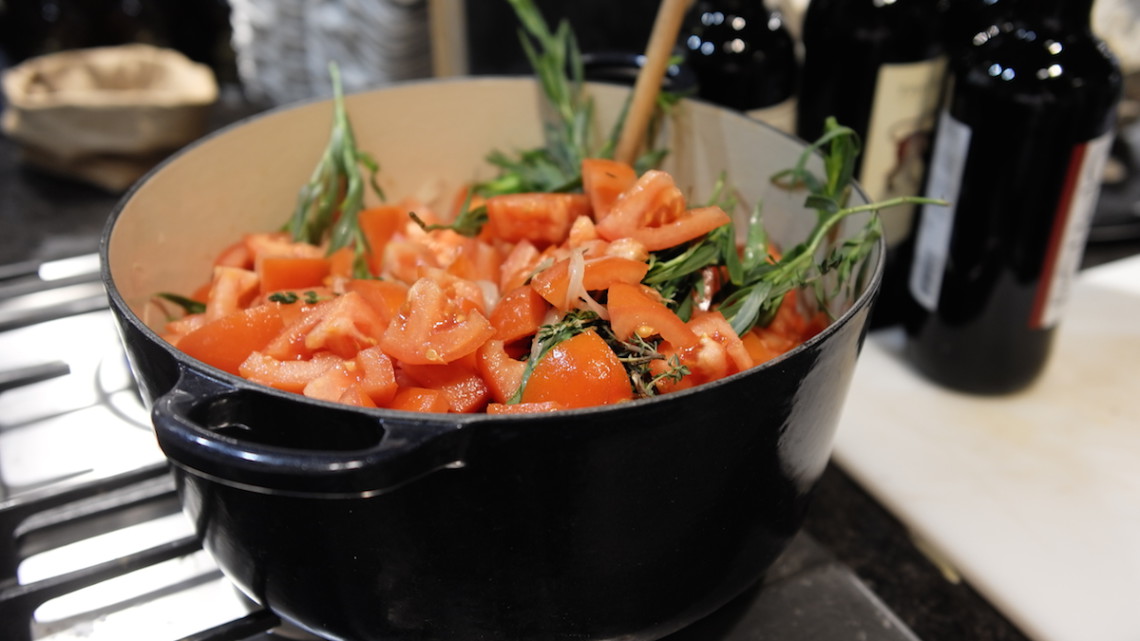Lamb Chop with Hummus and Feta
Spring is here and lamb is now at it's best. It lends itself well to many different cooking methods and flavours, the most well known being mint, garlic and rosemary. Here we've taken a mediterranean influence to our dish, with flavours the really compliment one another.
Serves 4
Ingredients
4 lamb chops
2 aubergines
2 red onions
2 tins chickpeas
1 lemon
100 g piece feta
1 bunch mint
2 tablespoons olive oil
6 tablespoons sunflower oil
salt
pepper
Method
1
Slice the aubergines and finely slice the red onions. Place the red onion in a bowl with lemon juice to taste, 2 tablespoon olive oil, salt and pepper.
2
Drain the liquid from the chickpeas and place them in a jug or tall container. Crumble in half the feta, add 2-4 tablespoons water and blend with a stick blender. Heat a frying pan with 3 tablespoons sunflower oil and fry the aubergine slices until golden. Season with salt and pepper.
3
Heat a grill pan with 3 tablespoons sunflower oil. Season the lamb chops with salt and pepper and grill for about 3 minutes on each side.
4
Pick the mint leaves and finely shred. Mix through the red onion relish. Divide the hummus between 4 plates and lay a lamb chop on top. Serve with the red onion relish and aubergines.
Lamb Cutlets with Lentils, Coriander & Mint dressing and Masala Yoghurt
A modern dish inspired by the flavours of India. Lightly spiced and complemented by coriander and mint, two of the best pairings with lamb.
Serves 4
Ingredients
2 lamb racks
salt
pepper
olive oil
200 g beluga or puy lentils
2 shallots
3 sprigs thyme
1 bunch coriander
1 bunch mint
250 ml natural yoghurt
1-2 tablespoons garam masala
coriander cress, to garnish
Method
Begin by making the coriander and mint dressing. Place the herbs in a blender. Add enough olive oil and blend to a dressing. Season with salt and pepper and set aside.
Finely chop the shallots. Heat a pan over medium heat with 2 tablespoons olive oil and sweat the shallots for 5 minutes. Add the lentils and thyme and fry for a further minute. Add water to cover, bring to the boil and simmer gently for 15-20 minutes until the lentils are cooked but still have a bite. Drain off the water, season with salt and pepper and about 2-3 tablespoons olive oil. Set aside.
Season the lamb cutlets with salt and pepper. Heat a frying pan over medium heat with 2 tablespoons olive oil and fry the lamb, fat side down until the fat has rendered down as much as possible and is golden brown. Turn over on to the meat side and fry for a further 1-2 minutes. Transfer to an oven tray and roast in a 200 oven for 15-17 minutes. Remove the lamb from the oven and allow to rest for at least 10 minutes lightly covered with a piece of aluminium foil.
Mix the natural yoghurt with garam masala to taste. Season with salt and pepper and 1 tablespoon olive oil.
Slice the lamb racks into cutlets. Divide the lentils between 4 plates. Lay 3-4 cutlets on each plate. Spoon over the coriander & mint dressing, masala yoghurt and top with the coriander cress.
Sausages with Lentils
Fennel and Pepperoncini Sausages with Lentils and Onion Chutney
Serves 2
Ingredients
4 Brandt & Levie fennel and pepperoncini sausages
200g Puy lentils
1 carrot
1 stick celery
1 onion
2 cloves garlic
3 sprigs thyme
80g balsamic-onion chutney (homemade or store bought)
6 tablespoons olive oil
1 heaped teaspoons Dijon mustard
salt
pepper
Method
1
Peel the carrot and finely chop along with the onion, celery and garlic cloves. Heat a pot over medium heat with 2 tablespoons olive oil and fry the chopped vegetables for about 5 minutes.
2
Add the lentils and thyme to the pot and enough water to just cover the lentils. Bring to the boil and simmer gently for about 20-30 minutes.
3
Heat a frying pan over medium heat with 2 tablespoons olive oil. Fry the sausages until golden brown and cooked through, about 12 minutes.
4
If the lentils are still too wet when cooked, pour off the excess water. Season with salt and pepper and a heaped teaspoon Dijon mustard. Stir through 2 tablespoons olive oil. Divide the lentils between 2 plates, slices the sausages, lay on top and serve with the onion chutney.
Sauerkraut with Sausages and Confit Duck
Serves 4
Ingredients
4 bratwurst or any of your favourite sausages
2 packs sauerkraut (zuurkool), about 800 gr
250 g lardons
2 onions
2 apples
olive oil
50 g butter
1 bottle beer
2 bay leaves
6 juniper berries
salt
pepper
boiled potatoes, to serve
4 confit duck legs, to serve
mustard, to serve
Method
Finely slice the onions. Peel the apples, discard the core and cut into 1 cm cubes. Place the sauerkraut in a sieve and rinse under cold running water. Dry the sauerkraut well. Heat a wok with 2 tablespoons olive oil and stir fry the sauerkraut until lightly caramelised. Remove from the heat and set aside.
Heat a large heavy pot over medium heat. Add 2 tablespoons olive oil and 50 g butter with the onion and lardons. Fry for 5 minutes. Add the stir fried sauerkraut, apple, the bottle of beer, juniper and bay leaves and cook gently over a low heat, covered with a lid, for about 40 minutes.
Heat a frying pan over medium heat. Add 2 tablespoons olive oil to the pan and fry the sausages for about 12 minutes until golden brown and cooked through.
Season the sauerkraut with salt and pepper. Serve with the sausages and confit duck, boiled potatoes and a little mustard, if you wish.
We, the Amsterdam Flavours chefs, hope you enjoy this recipe as much as we do. If you have any questions on how to prepare it or just want to send us your feedback, you can reach us here Contact Amsterdam Flavours
Pheasant with Brussel Sprouts, Chestnuts and Bacon
Serves 2
Ingredients
3 pheasant breasts (120g per piece)
200 g vacuum packed chestnuts
125 g smoked bacon lardons
300 g Brussel sprouts
125 ml cream
20 g butter
4 Tablespoons olive oil
75 ml red wine
75 ml Port
Salt and freshly ground black pepper
Method
Bring a pot of salted water to the boil. Add the Brussel sprouts to the pot and cook for 2 minutes. Transfer the sprouts to a bowl of cold water to stop the cooking.
Heat a frying pan over medium heat with 2 tablespoon olive oil and fry the lardons until golden brown. Add the chestnuts and Brussel sprouts and fry for 1 minute. Add the cream, salt and pepper and simmer gently until the cream coats the ingredients.
Check the pheasant breasts for any shot (little pieces of bullet). Season with salt and pepper. Heat a frying pan over medium heat with 2 tablespoons olive oil. Lay the pheasant, skin-side down in the pan and fry for 2 minutes. Turn over and fry for a further 1 minute (the pheasant breasts should still be pink inside).
Remove the pheasant from the pan and set aside. Deglaze the pan with 75 ml red wine and 75 ml port and reduce until the sauce becomes thicker. Stir 20 g butter through. Slice the pheasant breasts diagonally. Spoon the creamy Brussel sprouts and chestnuts in the middle of 2 plates. Lay the pheasant on top and spoon over the sauce.
We, the Amsterdam Flavours chefs, hope you enjoy this recipe as much as we do. If you have any questions on how to prepare it or just want to send us your feedback, you can reach us here Contact Amsterdam Flavours
Klik hier voor het recept in Nederlands.
Soft Polenta with Sausage Ragout
Serves 2
Ingredients
1 onion
1 garlic clove
4 salciccia or Italian sausages
1 tin chopped tomatoes
1 chicken stock cube
1 tin tomato paste
2 sprigs rosemary
120 g quick cook polenta
75 g smoked cheese
2 Tablespoons olive oil
Salt and freshly ground black pepper
Method
Finely chop the onion, garlic and rosemary leaves. Remove the skins from the sausages. Dissolve a quarter of the chicken stock cube in 100 ml hot water. Bring a pot with 300 ml water to the boil.
Heat a frying pan over medium-high heat with 2 tablespoons olive oil. Fry the onion for 3 minutes. Add the garlic and fry for a further 1 minute. Add 1 tablespoon tomato paste and fry for 1 minute. Add the sausage meat to the pan, breaking the meat up well with a wooden spoon. Fry for about 3-4 minutes. Add the tin of chopped tomatoes, the stock and rosemary to the pan. Bring to the boil and simmer gently, uncovered, for 8-10 minutes until the liquid has partially reduced.
Add the polenta to the pot of boiling water and cook gently, stirring continuously, for 5 minutes. Grate the smoked cheese; add to the polenta along with some salt and pepper.
Season the sausage ragout with salt and pepper. Divide the polenta between 2 plates and spoon over the ragout.
We, the Amsterdam Flavours chefs, hope you enjoy this recipe as much as we do. If you have any questions on how to prepare it or just want to send us your feedback, you can reach us here Contact Amsterdam Flavours
Klik hier voor het recept in Nederlands.
Sumac Veal Schnitzel with Cauliflower Salad
Serves 2
Ingredients
600 g cauliflower
2 Tablespoons tahini
1 lemon
2 veal schnitzels of 150 g each
2 Tablespoons sumac
50 g rocket
40 g almonds
40 g raisins
50 g panko breadcrumbs
olive oil
salt and pepper
Method
Preheat the oven to 200° C. Cut the cauliflower into florets and place them together with the almonds in a roasting dish with 2-3 tablespoons olive oil, salt and pepper. Roast in the oven for 25 minutes, stirring now and again.
In a small bowl, mix together 2 tablespoons tahini, 2 tablespoons olive oil, lemon juice to taste and 6 tablespoons lukewarm water. Season with salt and pepper. This is the dressing.
Rub the schnitzels in with a drizzle of olive oil, salt and pepper. Mix the panko and sumac together in a bowl. Run the schnitzels through the panko mixture, pressing the crumbs well on to the meat. Heat a frying pan with 3 tablespoons olive oil and fry the schnitzels until golden on each side. Remove the cauliflower from the oven.
Add the raisins and rocket to the cauliflower. Divide the schnitzels and salad between 2 plates, drizzling the tahini dressing over the salad and serve straight away.
We, the Amsterdam Flavours chefs, hope you enjoy this recipe as much as we do. If you have any questions on how to prepare it or just want to send us your feedback, you can reach us here Contact Amsterdam Flavours
Pappardelle with Chorizo Ragu
One of our favourite cookery writers and stylists, Donna Hay, has inspired this recipe.
Serves 4
Ingredients
400 gr dried chorizo
1 tablespoon extra virgin olive oil
2 sprigs rosemary
1 red chilli
2 cloves garlic
salt and pepper
good glug of red wine (about 100 ml)
1 x 400 g can peeled tomatoes
2 tablespoons brown sugar
400 g pappradelle
250 g buffalo mozzarella
green salad, to serve
Method
Remove the cases from the chorizo and roughly chop. Place into a Magimix (foodprocessor) and process until finely chopped, resembling minced meat. Set aside.
Bring a pan of salted water to the boil for the pasta. Finely chop the garlic, deseed the chilli and finely chop half of it (or more depending on how spicy you like it). Heat the olive oil in a large frying pan over medium-high heat. Strip trip the leaves from the rosemary stalks and chop them roughly. Add the rosemary to the pan and cook for 30 seconds until crisp. Remove and set aside. Add the chorizo, garlic, chilli, salt and pepper to the pan and cook for 3-4 minutes until golden and crispy, stirring often.
Add the wine and cooked cook for 30 seconds to 1 minute. Add the tomatoes and brown sugar and bring to a simmer. Turn the heat to low and cook for 5-7 minutes. ( If you find that too much oil has come from the chorizo, you can also spoon a little off). While the chorizo is cooking, cook the pasta in the boiling water according to the package instructions. Drain and reserve 100 ml of the cooking liquid.
Add a little of the reserved cooking liquid to the chorizo mixture to start with, making sure ragu has a nice consistency. Divide the pasta between 4 bowls. Top with the chorizo ragu and tear the mozzarella over. Sprinkle over the crispy rosemary, drizzle with some of the chorizo oil in the pan and serve with a green salad simply dressed with olive oil.
Making Stock
Stocks or bouillons are the foundation of many important kitchen preparations; therefore the greatest possible care should be taken in their production.
Stock is not an end in itself – it is always used to make some other dish or as a basis for sauces. A stock is the liquid obtained from long, gentle simmering of bones, vegetables, seasonings and water (except fish stock which only requires 20 minutes). The liquid, strained and reduced down to concentrate its flavour by rapid boiling, is the basis of soups, stews, braises and sauces.
In cooking stock, the prime essential is patience. Classic cookbooks recommend cooking veal stock for 10-12 hours. Three hours will suffice for chicken stock and fish stock is completed relatively quickly in half an hour.
During the cooking process, all the flavour should have been extracted from the bones and vegetables, leaving them tasteless. As well as flavour, good stock should acquire body from bone marrow and when chilled it will set to a jelly.
LE FONDS – THE STOCKS
Stocks, which are clear, flavoured liquids, are the foundation of many kitchen preparations. Therefore the greatest possible care should be taken with them.
- Unsound meat or bones and decaying vegetables should not be used
- Scum should be removed continuously so that it does not boil back into the stock
- The pot should be skimmed regularly and only simmer gently
- Do not add turnip, potato or other items that will cloud stock
- Always keep the inside of the pot clean and free of grease and scum
- Keep stock in clean containers in the refrigerator or freezer to avoid souring
GENERAL PROPORTIONS OF INGREDIENTS FOR ALL STOCKS EXCEPT FISH
5 liters water
2 kg raw bones
500g vegetables (onion, carrot, celery leek)
Bouquet garni including thyme, bay leaf, parsley stalks
GENERAL METHOD FOR ALL BROWN STOCKS
Chop the bones, remove any skin or fat and brown well on all sides by placing in a roasting pan in the oven.
Drain off any fat and place the bones in a stockpot.
Brown any sediment that may be in the bottom of the tray, déglace (swill out) with boiling water, simmer for a few minutes and add to the bones.
Wash, peel and roughly cut the vegetables. Fry in a little fat (from the roasting tray) until well browned but not burnt. This will improve the colour of the stock. Add to the bones.
Add the cold water. Bring to the boil and skim. Then add the bouquet garni.
Simmer for 6-8 hours wiping the inside of the pot continually to remove impurities. Skim and strain.
NOTE: For brown stocks, a few tomatoes and washed mushroom trimmings may also be added to improve flavour.
BROWN VEAL STOCK
For brown veal stock, use the same ingredients as for the chicken stock, substituting veal bones for the chicken. Place 2-2,5kg veal bones in a roasting pan and roast in the oven for 30-40 minutes until well browned, stirring occasionally. Add the vegetables and brown them also, about 15-20 minutes longer. Thorough browning gives stock flavour and colour. Transfer the vegetables and bones to the stockpot. Discard the fat from the pan and deglaze with 500ml water. Add the liquid to the pot, then make the stock. Add the garlic, 1 chopped tomato or 1 tablespoon tomato puree, bouquet garni and peppercorns. Simmer for 6-8 hours.
We, the Amsterdam Flavours chefs, hope you enjoy this recipe as much as we do. If you have any questions on how to prepare it or just want to send us your feedback, you can reach us here Contact Amsterdam Flavours
Tomato Shallot Sauce
This is a super delicious sauce to serve with roasted beef. We usually serve it with a roasted Simmenthaler beef fillet. It requires a little care and time to make, but the results are so worth it.
Serves 6
Ingredients
6 shallots, chopped
1 clove garlic, chopped
35 g unsalted butter
8 ripe tomatoes, deseeded and roughly chopped
sprig of tarragon
sprig of thyme
1 bay leaf
250 ml red wine
200 ml dry Madeira
100 ml Port
300 ml veal or chicken stock
salt and freshly ground black pepper
Method
Gently cook the shallots and garlic in 20g of the butter until very soft. Purée in a blender and place in a clean pan with the tomatoes, tarragon, thyme and bay leaf. Cook gently for five minutes or until the tomatoes start to break down.
Add the red wine, bring to the boil and cook until the liquid is reduced by half. Pour in the Madeira and Port, boil and reduce again by half. Add the stock and bring to the boil. Skim and simmer for 30 minutes.
Pass the sauce through a fine sieve and pour into a clean pan, bring to the boil and cook for about two minutes or until the desired consistency is achieved. Whisk in the remaining butter and season with salt and freshly ground black pepper and keep warm until ready to use.
We, the Amsterdam Flavours chefs, hope you enjoy this recipe as much as we do. If you have any questions on how to prepare it or just want to send us your feedback, you can reach us here Contact Amsterdam Flavours

